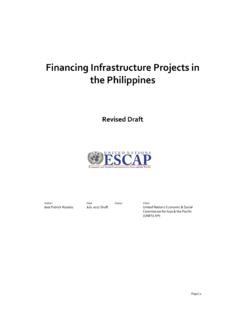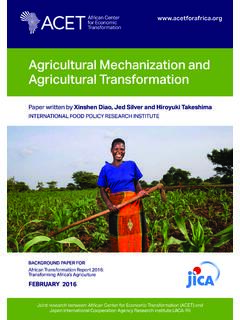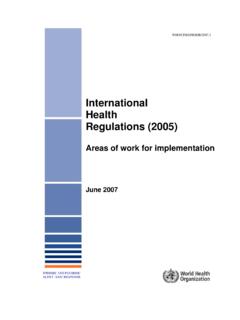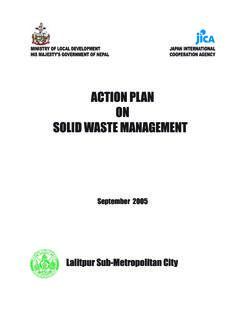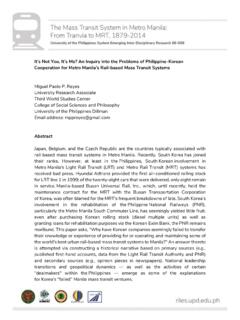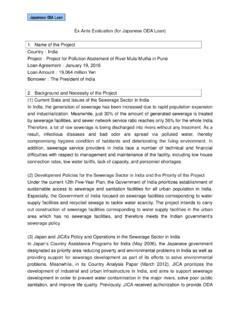Transcription of PROJECT CONCEPT PAPER TEMPLATE - Asian Development …
1 CONCEPT PAPER PROJECT Number: 46374-002 November 2012 Proposed Multitranche Financing Facility Sri Lanka: Southern Highways Investment Program CURRENCY EQUIVALENTS (as of 28 November 2012) Currency unit Sri Lanka rupee/s (SLRe/SLRs) = $ $ = SLRs ABBREVIATIONS ADB jica Asian Development Bank japan international cooperation agency km kilometer MFF multitranche financing facility MOPH OCR Ministry of Ports and Highways ordinary capital resources PPP Public Private Partnership RDA Road Development Authority TA technical assistance NOTE In this report, "$" refers to US dollars. Vice-President X. Zhao, Operations 1 Director General J. Miranda, South Asia Department (SARD) Director S. Widowati, Transport and Communications Division, SARD Team leader C.
2 Chen, Transport Specialist, SARD Team members S. Muthugala, Senior Procurement Officer, Sri Lanka Resident Mission, SARD A. Nanayakkara, Senior PROJECT Officer (Road and Transport), Sri Lanka Resident Mission, SARD Peri, Principal Transport Specialist, SARD Y. Seo, Counsel, Office of the General Counsel W. Tawisook, Transport Specialist, SARD Tilakaratne, Senior PROJECT Officer, Sri Lanka Resident Mission, SARD K. Yangzom, Environment Specialist, SARD S. Zhao, Social Development Specialist, SARD Peer reviewer R. Ishenaliev, Transport Specialist, Southeast Asia Department Lewis, Infrastructure Specialist (Public-Private Partnership), Regional and Sustainable Development Department In preparing any country program or strategy, financing any PROJECT , or by making any designation of or reference to a particular territory or geographic area in this document, the Asian Development Bank does not intend to make any judgments as to the legal or other status of any territory or area.
3 CONTENTS Page I. THE INVESTMENT PROGRAM 1 A. Rationale 1 B. Impact, Outcome, and Outputs 3 C. Investment and Financing Plans 3 D. Indicative Implementation Arrangements 4 II. TECHNICAL ASSISTANCE 4 III. DUE DILIGENCE REQUIRED 4 IV. PROCESSING PLAN 6 A. Risk Categorization 6 B. Resource Requirements 6 C. Processing Schedule 6 V. KEY ISSUES 6 APPENDIXES 1. Basic PROJECT Information 7 2. Problem Tree 8 3. Design And Monitoring Framework For The Investment Program 9 4. PROJECT Preparatory Technical Assistance 11 5. Initial Poverty And Social Analysis 16 I. THE INVESTMENT PROGRAM A. Rationale 1. The proposed investment program will improve the efficiency of road network in the south region of Sri Lanka to handle the fast-growing travel demand incurred by the economic and social In order to address the bottlenecks of national road network in Southern Province and Western Province, the investment program will (i) rehabilitate about 35 kilometers (km) of national highways providing access to the Southern Expressway, (ii) extend the Southern Expressway by constructing about 40 km of elevated expressway towards the origins and destinations of traffic in Western Province, and (iii) improve the efficiency of the Ministry of Ports and Highways (MOPH)
4 To operate the expressway network and the associated facilities. The proposed investment program, together with the earlier Southern Transport Development PROJECT ,2 will lay the foundations for modernizing the country s transport sector. 2. Strategic Context. Western Province is the most densely populated province in Sri Lanka. It drives the performance of country economy with a contribution of over 45% of national gross domestic product in 2010. The economy of Southern Province is closely integrated with Western Province through the physical and economic connection improved in the last two decades. The government envisages the Western Province as a regional center hub of South Asia and the Southern Province as a strategic area complementary to the Western Province on the international trade corridor with its rich natural and human 3.
5 The most significant accomplishment of transport sector in connecting the two provinces is the opening of Southern Expressway on 27th November 2011. The 96 km expressway is the first access-controlled high capacity road in Sri Lanka, which starts at Kottawa, a suburb 18 km away from Colombo, and ends at Galle, the capital of Southern Province. The construction of Southern Expressway was financed by Asian Development bank (ADB) and japan international cooperation agency ( jica ). After the road was opened to traffic, the travel time between Kottawa and Galle is reduced from 5 hours to hour. It is expected by the government that the Southern Expressway will serve as the backbone of the road network in Southern and Western Provinces by providing facilities for both passenger and freight vehicles to run over 80 km per hour.
6 4. Road Map. The Development and operation of Southern Expressway is re-defining the profile of Sri Lanka s road transport. Prior to the era of Southern Expressway, the road transport is characterized by low capacity road network, poor road conditions, and slow traffic speeds. With the opening of Southern Expressway, the government is on the way to establish a trunk road network comprising well-connected expressways and national roads, which can adequately support the movement of people and goods for economic 1 A PROJECT preparatory technical assistance (PPTA) is proposed with details provided in Appendix 4. An expressway operation, maintenance and management division is created within the Road 2 ADB.
7 1999. Report and Recommendation of the President to the Board of Directors: Proposed Loan to the Democratic Socialist Republic of Sri Lanka for the Southern Transport Development PROJECT . Manila (Loan 1711-SRI[SF], approved on 25 November). ADB. 2008. Report and Recommendation of the President to the Board of Directors: Proposed Loan and Technical Assistance Grants to the Democratic Socialist Republic of Sri Lanka for the Southern Transport Development PROJECT . Manila (Supplementary Loan 2413-SRI, approved on 6 March). 3 Government of Sri Lanka, Ministry of Finance and Planning, Department of National Planning. 2010. Sri Lanka: The Emerging Wonder of Asia: Mahinda Chintana Vision for the Future.
8 Colombo. 4 Road Development Authority, Planning Division. 2007. National Road Master Plan 2007-2017. Colombo. 2 Development Authority (RDA) of MOPH to manage the expressway operation, but its capacity is severely handicapped by the weak business process and poor human resources. 5. Despite the success of Southern Expressway, its envisaged benefits have not been reached optimally due to (i) the relatively long distance to Colombo city, which is the main passenger and freight traffic origin and destination, (ii) the poor condition of feeder roads, and (iii) the limited capacity of expressway operation. The average daily traffic passing the eight interchanges of Southern Expressway is about 8,500 vehicles, with light passenger vehicles comprising about 96% of total volume.
9 A large portion of freight transport between the two provinces still uses the coastal National Highway A2: Colombo-Galle-Matara mainly because it normally takes one to two hours to enter the expressway at Kottawa interchange. The proposed investment program will extend the Southern Expressway towards the traffic origins and destinations in Colombo city, so that the traffic, mainly the freight, can be shifted from a coastal route which is vulnerable to climate change, to a climate resilient expressway corridor. 6. The government is actively expanding the expressway network. Besides the Southern Expressway, a number of projects are in the pipeline, including (i) Outer Circular Highway, (ii) Colombo-Katunayaka Expressway, (iii) Pinnaduwa-Gagodama Expressway, and (iv) Colombo-Kandy Expressway.
10 The Development and operation models of Southern Expressway will be followed in these projects and future expansion of expressway network. To serve the purpose of a model PROJECT , the physical and nonphysical bottlenecks on Southern Expressway and the associated facilities needs to be addressed properly. 7. To bring in investment from the private sector in terms of expressway PROJECT implementation, operations, and management, the government intends to avail the financial resource and the capacity of private sector to develop the Southern Expressway Extension through a public-private partnership model. This PROJECT will be the first of its kind in the country, and will serve as a catalyst to set in place a public-private partnership (PPP) framework for infrastructure projects in the transport sector.










